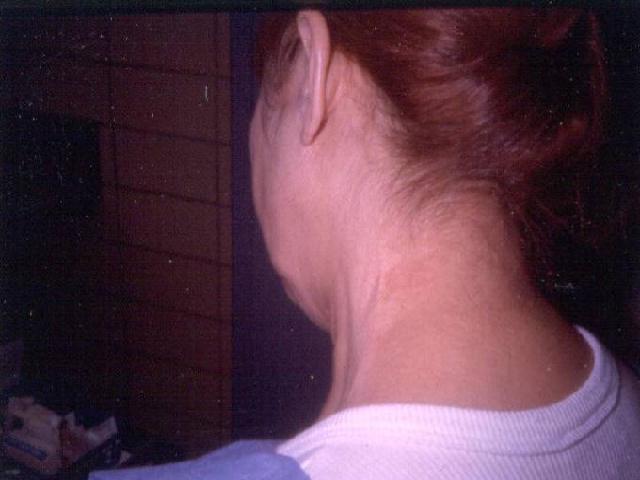CORRECT DIAGNOSIS:
Pseudoxanthoma Elasticum
DISCUSSION:
Pseudoxanthoma Elasticum is a serious hereditary disorder of the connective tissue that primarily involves the elastic tissues of the skin, blood vessels, and eyes. The incidence is 1:40,000 to 1:160,000 and the age of onset is 20 -30 y.o. Most commonly the inheritance is autosomal recessive. Patients present with asymptomatic skin lesions, which often develop in childhood. Systemic complaints consist of decreased visual acuity, coronary artery disease, and peripheral vascular disease.
Clinically, a peau d’ orange surface pattern is seen with, multiple, yellow, soft, papules which often coalesce into larger plaques. The skin is soft and lax and hangs in folds giving the appearance of “chicken skin”. Areas of involvement include the neck, axillae, groin, abdomen, and thighs. Mucous membranes may be involved with yellow papules on the soft palate, rectum, and vagina. Peripheral pulses may be decreased and eye findings include angioid streaks. For diagnosis, a biopsy of lesional skin, normal skin, or a scar may be done. A biopsy of a scar may show changes of PXE before typical skin changes are evident.
TREATMENT:
There are currently no curative treatments. Genetic counseling and evaluation of all family members for PXE is standard. The patient’s obstetrician must be aware of the diagnosis. Referral to the appropriate specialist for w/u and f/u such as ophthalmology, GI, and cardiology is essential. Other treatments include avoidance of vitamin D3, dialysis, and nutritional restrictions including, calcium. Surgery may be considered for disfiguring cutaneous changes.
REFERENCES:
Fitzpatrick, T., et al. (1997). Pseudoxanthoma elasticum. In Color atlas and synopsis of clinical dermatology (3rd ed., pp. 448–450). McGraw-Hill.
Hammaty, Y., Nagai, K., et al. (2000). Hyperactivity of PXE-affected dermis to vitamin D3. Journal of the American Academy of Dermatology, 42(4), 685–687. https://doi.org/10.1016/S0190-9622(00)90027-2 [PMID: 10761519]
Sapadin, A. N., Lebwohl, M. G., et al. (1998). Periumbilical PXE associated with chronic renal failure and angioid streaks: Apparent regression with hemodialysis. Journal of the American Academy of Dermatology, 39(3), 338–344. https://doi.org/10.1016/S0190-9622(98)70068-0 [PMID: 9731388]
Sherer, D. W., & Lebwohl, M. G. (1999). Pseudoxanthoma elasticum: An update. Dermatology, 199(1), 3–7. https://doi.org/10.1159/000018503 [PMID: 10363349]




